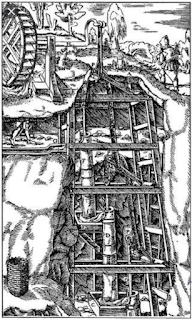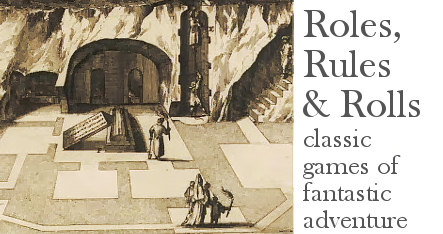In
writing adventure material, nothing pays off like primary research. Look into
the lives of rats, and you find that they are purblind and communicate
subvocally. Pay attention to stone, and you find that at the juncture of
limestone and granite sometimes grows a layer called skarn, laced with gold,
copper, and gems. Architecture, chemistry, botany: as much as they constrain
design with realism, they also open up intriguing possibilities with the ring
of reality to them.
Lack of
research also shows. How many lost mines, dwarven or not, have been written up
for adventures? How many of them have been glommed together from the residue of
Moria-sublime (halls, chasms, demons) and Wild-West-banal (railcarts, lifts,
ingots)? The one thing that's certain is that horrible things from the deep
have been unleashed and are now running around in the place. But can we do
better in setting the scene?
 |
| Waterwheel-driven pump |
Even
cursory research turns up one detail of deep metal mining, in medieval Europe
or any other civilization, that presents enormous challenges. Below the water
table, mines tend to flood. The simplest solution: dig a drainage channel, or
adit, to lower ground. But this presumes your mine sits on higher ground from
somewhere. Deep mines don't have this luxury.
So, pump
the water out. At first people pass buckets hand to hand, then as craft
deepens, machines use hand power, mule power, water power to lift out the
groundwater using buckets, screws, suction pipes and tubes. All these latter
solutions need keeping up, and once the mine is abandoned, the lower levels
partly or fully fill with water.
Flooded
floors, concealing pits and swimming monsters; flooded tunnels, requiring magic
light and water breathing to have any chance of mere survival. Or, another way:
get the old pumping machinery working again and see how much you can clear out,
and what treasures lie in the murk.
All this
assumes a pre-industrial European level of technology. But a fantasy world also
has dwarves, that people of notably precocious craft. Indeed, one solution only
they might reach comes from the computer construction game Dwarf Fortress,
whose worldbuilding is as complex as its graphics are crude. The game simulates
groundwater by having some settlements sit over an aquifer level, whose water floods and ruins
all construction beneath it. The way past the aquifer requires one of many
complicated engineering solutions, including rapid pumping, opening a shaft to
cold air that will freeze the water, or dropping a "plug" of dry
stone into the wet level and boring through it.
 |
| Dropping the "plug" |
Although Dwarf
Fortress simplifies the geological reality of seepage, the plug idea suggests
that dwarves might have the skill to locate the source of groundwater and
simply wall it off with non-porous stone. Maybe the water is controlled and
channeled into a reservoir, for drinking and industrial use.
Allow a
certain amount of magic in mining, and the pumping operation can be helped in a
dozen ways. Maybe the dwarven priests have deals with elementals, or maybe
these solutions are found among other underground peoples, like the dark elves.
Golems can be set the task of working the pumps. The miners themselves breathe
water in flooded galleries. Magic freezes flooded caverns so that ice tunnels
can be dug through. A portable hole, or elemental portal, does the work of an
adit in draining off water. And what might come through the portal the wrong
way?
Another
difference: human metal production historically had to be distributed over
several sites, because the material for processing ore -- water, wood, and
aboveground oxygen -- was not present within a mine, and not necessarily
plentiful close to it. Dwarves, though, live entirely underground. Their mine
dungeons necessarily include areas for crushing ore, then sorting and filtering
the metal-bearing compounds through the action of water. They need to smelt ore
in the heat of a furnace, creating liquid metal. If steel is being made, the
fuel needs to infuse the raw iron with carbon. Most likely for dwarves this
will be mineral coal rather than the medieval-era charcoal. Why not have the
facilities for shaping and working metal objects right there to hand as well? A
whole complex suggests itself. The only limit is availability of fresh air and
water, which architecture or elementals need to supply. And Dwarf Fortress
gives another idea: using the earth's own magma to power fierce furnaces.
In short,
thinking about realistic logistics can take you places in design your
unconstrained imagination never would. It can insert unforeseen challenges into
mundane mines, or underwrite the need for a thematically varied industrial site
in the more fantastic variety.

